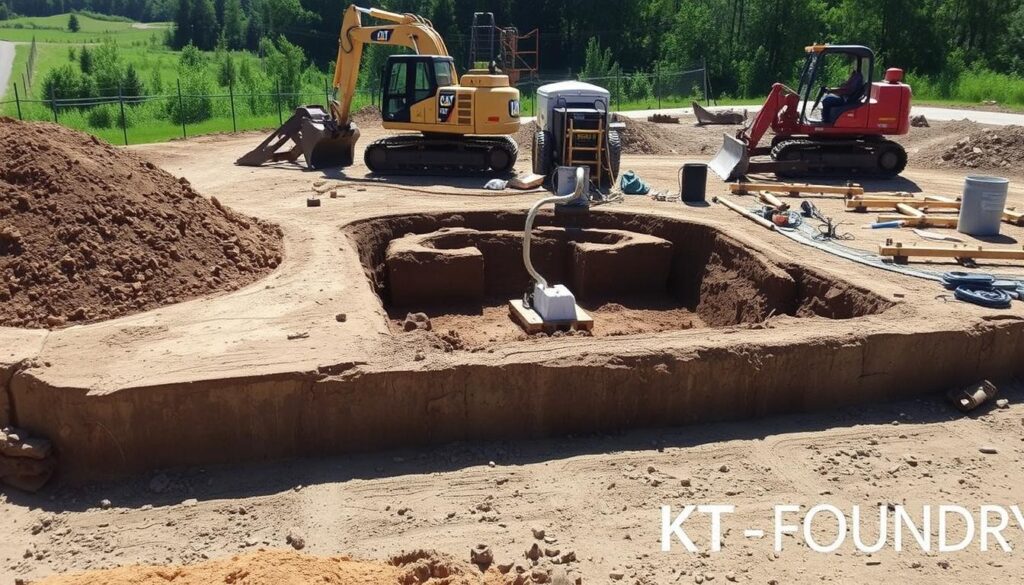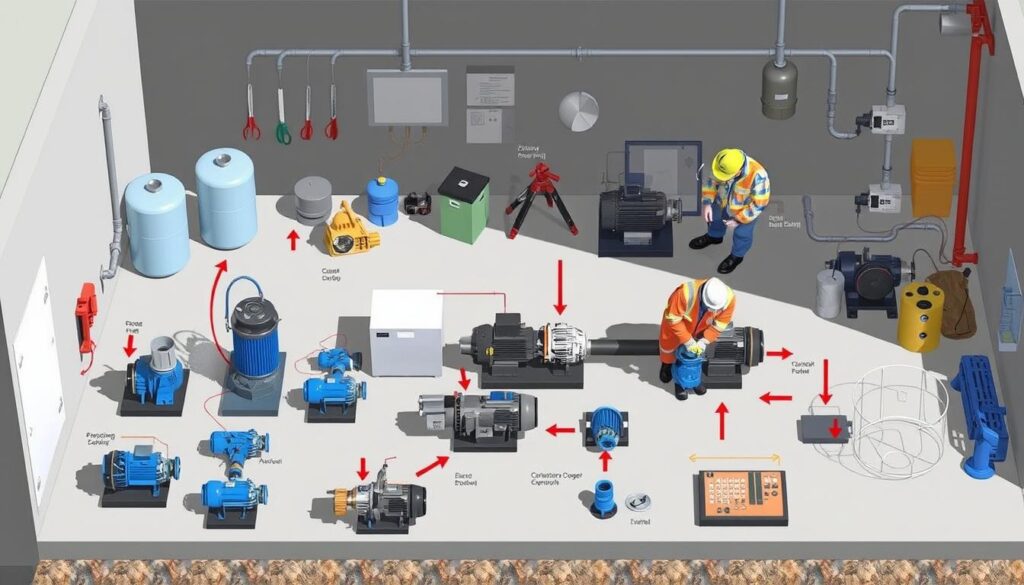Installing a pump is a detailed task that needs careful attention. If not done right, it can cause problems like less efficiency, frequent breakdowns, and even harm the environment. This guide will help you avoid common mistakes, ensuring your pump works well for a long time.
Key Takeaways
- Understand the importance of proper pump installation for optimal performance and longevity
- Learn essential steps to avoid common mistakes during pump installation
- Discover expert tips and advice to ensure a successful pump installation process
- Familiarize yourself with the necessary tools, equipment, and safety precautions
- Gain insights into site preparation, piping connections, electrical wiring, and start-up procedures
By following our guidelines and expert advice, you can save time and money. You’ll also avoid headaches during the pump installation. Our aim is to give you the knowledge and tools for a smooth and successful installation. This will lead to a more efficient and reliable system for you.
Pre-Installation Preparation
Before starting the installation, it’s important to prepare well. This means choosing the right pump for your needs. There are many types, like centrifugal, submersible, and positive displacement pumps. You need to think about flow rate, pressure, and the type of fluid you’re working with.
Choosing the Right Pump
Talking to experts at Enviro Pump Services in Sydney is a good idea. They can give you advice based on your system’s needs. Their team knows how to pick the best pump for you.
Planning and Design
Good planning and design are key for a smooth installation. First, look at your system’s needs, like flow rate and pressure. This helps you pick the right pump size. Also, think about where to put the pump, considering space and noise.
Gathering Necessary Tools and Equipment
- Wrenches
- Pipe cutters
- Couplings
- Thread sealants
- Electrical testing devices
Make sure you have all the tools you need before starting. This includes wrenches, pipe cutters, and safety gear. Safety items like gloves and safety glasses are important to avoid accidents.
“Proper preparation is the key to a successful pump installation. Take the time to plan and gather the necessary tools, and you’ll be well on your way to a seamless integration.”
By following these steps, you can set up your pump system for success. This ensures your system works well.
pump installation guidelines
Site Preparation
Getting the installation site ready is key. Make sure it’s clean, level, and free of debris. This helps the pump work well and avoids damage or accidents.
Check for obstacles like pipes or cables. Move them if needed to have a clear space. Good site prep means the pump will perform better and last longer.
Proper Piping and Connections
Choosing the right piping and connections is crucial. Pick materials that resist corrosion and can handle the pressure and fluid. Make sure the pipes fit well and are aligned right.
Use the right seals and connections to avoid leaks. This keeps the pump running smoothly and efficiently.
Electrical Connections
Safe and efficient pump operation starts with good electrical connections. Follow Australian electrical standards for wiring and grounding. Use the right wire size and conduit for protection.
Test the electrical connections before turning on the pump. This ensures everything works as it should.
Priming and Start-up Procedures
Priming the pump removes air and ensures water flows well. Follow the manufacturer’s guide for your pump’s priming method. After priming, start up the pump as the manual instructs.
Watch the system closely during start-up. Look for any odd noises, vibrations, or leaks. Make adjustments as needed to get the best performance.

Conclusion
Proper pump installation is key for good performance, long life, and safety. This guide helps us avoid common mistakes and do it right. Always plan well, use the right techniques, and follow safety rules and Australian standards.
If you need help or professional services, think about Enviro Pump Services in Sydney. They are known for their quality pump castings. These castings are durable, efficient, and perform well, helping your industrial needs.
Spending time and effort on proper pump installation is worth it. It ensures your pump works well and lasts long. By using the tips from this guide, we can make our pump systems more efficient and long-lasting. This helps our industrial processes succeed.
FAQ
What factors should be considered when choosing the right pump for an application?
When picking a pump, think about the flow rate and pressure needed. Also, consider the fluid’s properties and the environment. Experts at Enviro Pump Services in Sydney can offer advice tailored to your needs.
Why is thorough planning and design important for a successful pump installation?
Good planning and design are key for a pump to meet system demands. You need to figure out the flow rate and pressure needed. Also, pick the best spot for installation, keeping in mind space and noise.
What are the essential tools and equipment needed for a pump installation?
You’ll need wrenches, pipe cutters, and couplings for a pump installation. Don’t forget thread sealants and electrical testing tools. Always wear safety gear like gloves and glasses to stay safe.
Why is proper site preparation important for pump installation?
Make sure the site is clean and level for the pump to work well. Check for obstacles like pipes and adjust the site as needed. This helps avoid damage and accidents.
What are the key considerations for proper piping and connections during pump installation?
Choosing the right piping and connections is crucial for the pump’s performance. Use the right materials and ensure proper sizing and alignment. Tight seals and connections prevent leaks and flow issues.
How should the electrical connections be handled during pump installation?
Electrical connections must be done right for the pump’s safety and efficiency. Follow Australian standards for wiring and grounding. Use the right wire sizes and conduit for protection. Test the connections before turning on the pump.
What are the key steps to follow during the priming and start-up procedures for a new pump installation?
Priming removes air from the system for proper water flow. Follow the pump’s manufacturer instructions for priming. After priming, start the pump as the manual suggests. Watch for any unusual sounds or leaks and adjust as needed.


